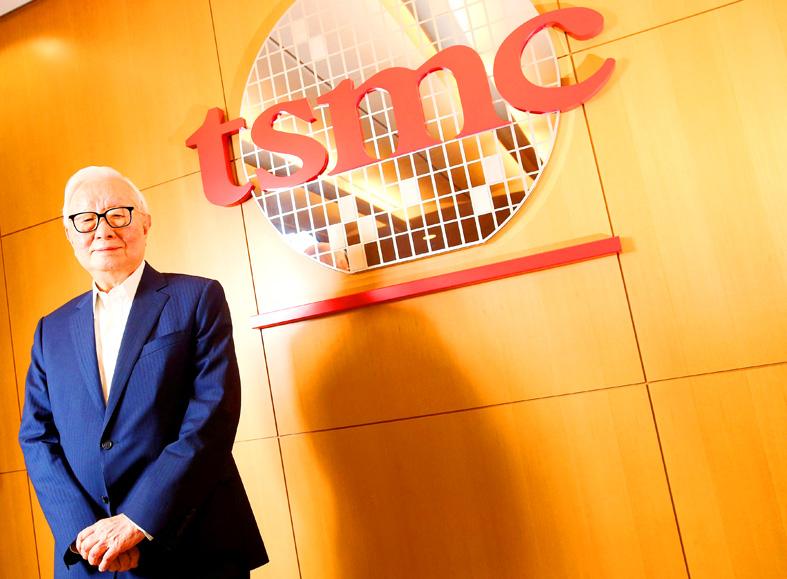The US’ efforts to increase onshore manufacturing of semiconductors is wasteful and an expensive exercise in futility due to a lack of manufacturing talent and high costs, Taiwan Semiconductor Manufacturing Co (TSMC, 台積電) founder Morris Chang (張忠謀) said on Tuesday.
Chang made the remarks in an interview with the Brookings Institution in its latest podcast on the theme “Can semiconductor manufacturing return to the US?”
The semiconductor veteran said that the US today still has a good position in the semiconductor technology industry in terms of chip design capacity, but it lacks sufficient manufacturing talent.

Photo: Reuters
“I don’t really think it is a bad thing for the US actually. But, it’s a bad thing for trying to do semi manufacturing in the US,” Chang said.
The US used to have strong talent, like Taiwan does now, he said.
However, after the 1970s, young talent in the US migrated to high-paying professions such as finance or consulting, rather than working for technology companies such as GE or IBM, he said.
Since then, US companies just could not get enough business school graduates, he added.
Another challenge is high manufacturing costs, Chang said.
For example, TSMC thought that its factory in Oregon, which was established in 1997, would have costs comparable to Taiwan, but that assumption was proved to be “naive,” he said.
TSMC has attempted to improve the factory’s performance by changing managers and engineers, he said.
While a few years of effort did improve the factory’s performance, the difference in cost between the US and Taiwan remains almost the same, he added.
Chips made at the Oregon factory cost 50 percent more than those make TSMC’s factories in Taiwan, Chang said.
Regarding TSMC’s new US$12 billion factory in Arizona, Chang said he had retired by 2019, but that chairman Mark Liu (劉德音) made the decision at the insistence of the US government.
TSMC, the sole chip supplier for Apple Inc’s iPhones, has said the Arizona factory is under construction, but aims to manufacture 5-nanometer chips by 2024.
Commenting on the US government’s efforts to increase onshore chip manufacturing by spending tens of billions dollars, Chang said: “I think it will be a very expensive exercise in futility.”
“The US will increase onshore manufacturing of semiconductors somewhat,” Chang said. “All that will be at a very high cost increase, high unit costs, but non-competitive in the world market when you compete with factories like TSMC.”
Regarding Intel CEO Pat Gelsinger’s remarks that “Taiwan is not safe,” Chang said he assumes that there will not be a war.
“If there is no war, then I think the efforts to increase onshore manufacturing of semiconductors is a wasteful and expensive exercise in futility," he said. “If there is a war, we all have a lot more than just chips to worry about.”

Taiwan Semiconductor Manufacturing Co (TSMC, 台積電) last week recorded an increase in the number of shareholders to the highest in almost eight months, despite its share price falling 3.38 percent from the previous week, Taiwan Stock Exchange data released on Saturday showed. As of Friday, TSMC had 1.88 million shareholders, the most since the week of April 25 and an increase of 31,870 from the previous week, the data showed. The number of shareholders jumped despite a drop of NT$50 (US$1.59), or 3.38 percent, in TSMC’s share price from a week earlier to NT$1,430, as investors took profits from their earlier gains

In a high-security Shenzhen laboratory, Chinese scientists have built what Washington has spent years trying to prevent: a prototype of a machine capable of producing the cutting-edge semiconductor chips that power artificial intelligence (AI), smartphones and weapons central to Western military dominance, Reuters has learned. Completed early this year and undergoing testing, the prototype fills nearly an entire factory floor. It was built by a team of former engineers from Dutch semiconductor giant ASML who reverse-engineered the company’s extreme ultraviolet lithography (EUV) machines, according to two people with knowledge of the project. EUV machines sit at the heart of a technological Cold

Taiwan’s long-term economic competitiveness will hinge not only on national champions like Taiwan Semiconductor Manufacturing Co. (TSMC, 台積電) but also on the widespread adoption of artificial intelligence (AI) and other emerging technologies, a US-based scholar has said. At a lecture in Taipei on Tuesday, Jeffrey Ding, assistant professor of political science at the George Washington University and author of "Technology and the Rise of Great Powers," argued that historical experience shows that general-purpose technologies (GPTs) — such as electricity, computers and now AI — shape long-term economic advantages through their diffusion across the broader economy. "What really matters is not who pioneers

TAIWAN VALUE CHAIN: Foxtron is to fully own Luxgen following the transaction and it plans to launch a new electric model, the Foxtron Bria, in Taiwan next year Yulon Motor Co (裕隆汽車) yesterday said that its board of directors approved the disposal of its electric vehicle (EV) unit, Luxgen Motor Co (納智捷汽車), to Foxtron Vehicle Technologies Co (鴻華先進) for NT$787.6 million (US$24.98 million). Foxtron, a half-half joint venture between Yulon affiliate Hua-Chuang Automobile Information Technical Center Co (華創車電) and Hon Hai Precision Industry Co (鴻海精密), expects to wrap up the deal in the first quarter of next year. Foxtron would fully own Luxgen following the transaction, including five car distributing companies, outlets and all employees. The deal is subject to the approval of the Fair Trade Commission, Foxtron said. “Foxtron will be